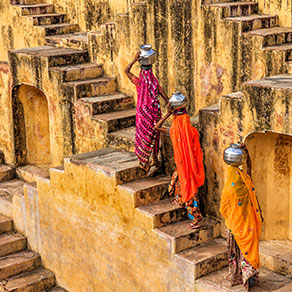Trip notes: Eight contemporary novels to read before you visit India
Yonder holidays aren’t the fly & flop type. Sure we all like a good hotel, but we travel to discover and learn, to connect with people, their places, and their culture. And what better way to connect with a culture than to read its stories.
A civilisation as ancient as India’s has a literary heritage that reaches back through the ages. But to help you relate and connect with modern India we’ve curated the following must-read contemporary novels for you to enjoy before your trip.
Pick up one or more of the following and get a headstart on the sights and sounds that await you in this complex, fascinating, and utterly bonkers nation.

Shortcut: our top picks reviewed in brief
The God of Small Things: a poignant exploration of familial relationships and societal taboos.
White Tiger: a riveting critique of India’s class struggle and a journey through the underbelly of Indian society.
Last Man in Tower: the collision of traditional values and rampant modernisation in a rapidly changing Mumbai.
Midnight’s Children: an immersive dive into India’s historical and political evolution through magical realism.
A Fine Balance: a deep exploration of human resilience and hope amidst political turmoil and socio-economic disparity.
The Inheritance of Loss: understanding the complexities of postcolonial identity and the immigrant experience.
The Palace of Illusions: a unique female perspective on an epic tale, challenging traditional narratives.
The God of Small Things
Arundhati Roy, 1997
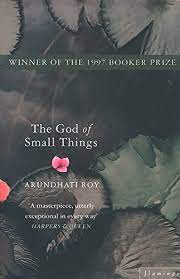 In her Man Booker Prize-winning debut novel, The God of Small Things, Arundhati Roy presents a captivating tale of twin siblings, Rahel and Estha, and their deeply troubled family in Kerala. Roy’s narrative is distinguished by its meticulous attention to detail, encapsulating the vast complexities of post-colonial Indian society within a microcosmic family drama.
In her Man Booker Prize-winning debut novel, The God of Small Things, Arundhati Roy presents a captivating tale of twin siblings, Rahel and Estha, and their deeply troubled family in Kerala. Roy’s narrative is distinguished by its meticulous attention to detail, encapsulating the vast complexities of post-colonial Indian society within a microcosmic family drama.
Set against a backdrop of immense socio-political change, the narrative is steeped in local culture, symbolisms, and the intricate caste system. The protagonists’ lives are profoundly influenced by the “Love Laws,” unspoken societal rules about who should be loved and how. These laws pose as a harsh reminder of the hierarchies that pervade even the most intimate aspects of life, marking individuals and determining their destinies.
Roy’s prose is rich and evocative, capturing the lush beauty of Kerala with vivid imagery while also addressing the heart-wrenching truths about human frailty and societal prejudice. The narrative does not follow a linear structure, but rather ebbs and flows through time, reflecting the lasting impacts of past tragedies on present circumstances.
The twins, Rahel and Estha, are portrayed with compelling depth and sincerity. Their innocence amidst the turmoil of the adult world and the irreversible consequences of a single tragic event result in a potent exploration of the fragility of childhood.
The God of Small Things is as much a poignant family saga as it is a commentary on the far-reaching implications of societal norms and prejudices. This masterpiece by Arundhati Roy will resonate with you long after the final page, invoking a reconsideration of the “small things” in life that invariably shape our destinies.
White Tiger
Aravind Adiga, 2008
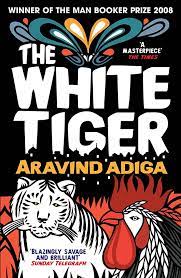 Aravind Adiga’s Man Booker Prize-winning novel, The White Tiger, is a dark yet witty narrative offering an unvarnished look into modern Indian society. The novel is presented as a confessional letter written by the protagonist, Balram Halwai, to the Chinese Premier, capturing the stark disparity between India’s rich and poor, urban and rural spaces, and their repercussions.
Aravind Adiga’s Man Booker Prize-winning novel, The White Tiger, is a dark yet witty narrative offering an unvarnished look into modern Indian society. The novel is presented as a confessional letter written by the protagonist, Balram Halwai, to the Chinese Premier, capturing the stark disparity between India’s rich and poor, urban and rural spaces, and their repercussions.
Balram, a self-proclaimed “social entrepreneur,” narrates his journey from a poor villager to a successful businessman in the sprawling metropolis of Bangalore. This transition is far from smooth, as it delves into themes of corruption, servitude, and moral compromise.
Adiga’s portrayal of Balram is immensely captivating – he is an anti-hero who elicits sympathy, despite his ruthless ambition and morally questionable actions. Balram’s voice is distinct and compelling; his wry observations and criticisms of the Indian elite are biting yet infused with a cynical humour that underscores the narrative.
The White Tiger excels in its depiction of the socio-economic chasm in Indian society. The author boldly addresses the systemic corruption and nepotism that are entrenched in both the political and social structures. The stark contrast between the ‘Light’ and ‘Darkness’ of India is reflected not only geographically but also symbolically, representing the dichotomy of India’s growth narrative.
Adiga’s prose is stark and incisive, laying bare the realities of India’s underbelly. While the novel may be uncomfortable to some due to its unflinching honesty, it is this very candour that makes The White Tiger a seminal work in contemporary Indian literature.
Last Man in Tower
Aravind Adiga, 2011
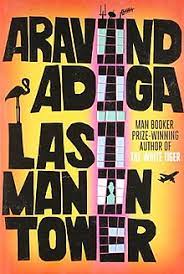 Also by Aravind Adiga, Last Man in Tower is a thought-provoking novel that takes you to the heart of a rapidly changing Mumbai, where gleaming new skyscrapers stand in stark contrast to the city’s old, dilapidated buildings. At the centre of the narrative is the protagonist, retired schoolteacher Yogesh Murthy, affectionately known as Masterji.
Also by Aravind Adiga, Last Man in Tower is a thought-provoking novel that takes you to the heart of a rapidly changing Mumbai, where gleaming new skyscrapers stand in stark contrast to the city’s old, dilapidated buildings. At the centre of the narrative is the protagonist, retired schoolteacher Yogesh Murthy, affectionately known as Masterji.
Adiga draws you into the microcosm of the Vishram Society tower, a cooperative housing society in Mumbai. You observe Masterji’s stubborn refusal to sell his apartment to a powerful property developer, despite being the last remaining resident opposing the lucrative offer.
The narrative encapsulates the city’s transforming skyline as a symbol of India’s economic growth and the resulting societal shifts. Adiga paints a vivid picture of the city and the Vishram Society, making you feel the tension build as Masterji’s neighbours turn against him.
Adiga’s portrayal of Masterji and the other characters is detailed and empathetic. As you traverse the story, you may find yourself experiencing a range of emotions — from sympathy and admiration for Masterji’s principles, to frustration at his obstinacy, and sadness for the eventual outcome.
As you delve into Last Man in Tower, you explore deeper themes of greed, community, and the price of progress. Adiga’s Mumbai is a city of contradictions, and his characters mirror these complexities. By the end of the book, you may find yourself pondering over the complexities of urbanisation and the human cost of progress.
Last Man in Tower is a compelling read that offers a keen examination of modern India. It leaves you with a lingering thought: in the face of relentless modernisation, what happens to those who stand in its way? This narrative will resonate with you, as it encapsulates universal themes of change, resistance, and the indomitable human spirit.
Midnight’s Children
Salman Rushdie, 1981
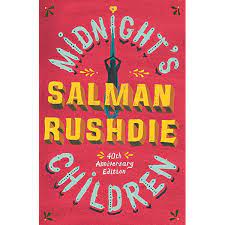 In Midnight’s Children, Salman Rushdie weaves a dazzling tapestry of postcolonial India, blending history and fantasy in an explosion of vibrant storytelling. This Booker Prize-winning novel recounts the story of Saleem Sinai, a boy born on the stroke of midnight, at the precise moment of India’s independence from British rule.
In Midnight’s Children, Salman Rushdie weaves a dazzling tapestry of postcolonial India, blending history and fantasy in an explosion of vibrant storytelling. This Booker Prize-winning novel recounts the story of Saleem Sinai, a boy born on the stroke of midnight, at the precise moment of India’s independence from British rule.
Saleem’s life is inextricably intertwined with the fate of his newly independent nation. He is bestowed with telepathic powers, as are the other 1,000 ‘midnight’s children,’ all born in the first hour of India’s independence. Their lives mirror the tumultuous events of India’s journey, from the partition and creation of Pakistan, to the imposition of ‘Emergency’ by Prime Minister Indira Gandhi.
Rushdie’s narrative is complex and intricate, told through Saleem’s perspective as he recalls his life’s journey to a young listener. The narrative structure, often flitting between different timelines, is imbued with Rushdie’s characteristic magical realism, adding a layer of fantastical wonder to the historical backdrop.
The novel is rich with symbolism and allegory, using Saleem’s telepathy as a metaphor for the interconnectedness of diverse experiences within India. The chaos of Saleem’s narrative mirrors the tumultuous nature of a country grappling with its newfound independence and the challenges it entails.
In his vivid portrayal of India, Rushdie addresses themes of identity, belonging, and postcolonialism, against the backdrop of a nation undergoing significant transition. His writing is lush with detail, bringing to life the sights, sounds, and smells of India and creating a sense of place that is deeply immersive.
Midnight’s Children is a tour de force of magical realism and a deep dive into the soul of postcolonial India. Rushdie’s distinctive storytelling style and imaginative narrative make this novel a landmark in the world of literature, offering an extraordinary journey through India’s history and the human condition.
A Fine Balance
Rohinton Mistry, 1995
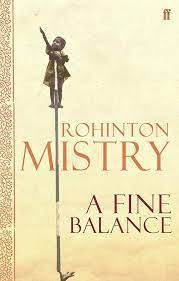 In A Fine Balance, Rohinton Mistry transports you to 1975 India, a time of political unrest and turmoil during ‘The Emergency’ declared by Prime Minister Indira Gandhi. The narrative intricately weaves the lives of four individuals, a widow, two tailors, and a student, each battling their own adversities amidst the sweeping changes.
In A Fine Balance, Rohinton Mistry transports you to 1975 India, a time of political unrest and turmoil during ‘The Emergency’ declared by Prime Minister Indira Gandhi. The narrative intricately weaves the lives of four individuals, a widow, two tailors, and a student, each battling their own adversities amidst the sweeping changes.
As the plot develops, you become privy to their hardships, hopes, and resilience, while experiencing the harsh realities of life under a regime of widespread fear and uncertainty.
Mistry’s prose is rich with detail, painting a stark and vivid picture of India during a pivotal period in its history. You can almost feel the oppressive heat, taste the spicy tang of street food, and hear the cacophony of bustling markets.
The novel’s title hints at the delicate equilibrium between hope and despair that underscores the narrative. As you explore the characters’ lives, you’ll see how this balance is frequently disrupted, forcing them to constantly adjust to their ever-changing circumstances.
A Fine Balance is not just a glimpse into India’s past; it’s an exploration of the human spirit’s tenacity in the face of overwhelming adversity. As you close the book, you might find yourself deeply moved and perhaps more appreciative of the delicate balance that makes up life’s tapestry. This book leaves you with a potent blend of melancholy and admiration for its characters, who despite their circumstances, continue to strive for a life of dignity and purpose.
The Inheritance of Loss
Kiran Desai, 2005
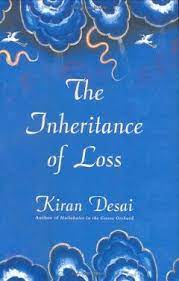 The Inheritance of Loss, a Man Booker Prize-winning novel by Kiran Desai, is a narrative that delicately explores themes of postcolonialism, immigration, and identity. As you delve into this book, you become absorbed in the entwined lives of the characters residing in an old, crumbling house in the foothills of the Himalayas.
The Inheritance of Loss, a Man Booker Prize-winning novel by Kiran Desai, is a narrative that delicately explores themes of postcolonialism, immigration, and identity. As you delve into this book, you become absorbed in the entwined lives of the characters residing in an old, crumbling house in the foothills of the Himalayas.
Desai expertly manoeuvres the narrative across continents, as you follow the journey of Biju, an illegal immigrant in the United States, and the trials of his father and other characters back in India. Their stories reflect the dichotomy of the immigrant experience – the often romanticised dreams of the West versus the harsh reality.
Throughout the narrative, you are presented with the legacy of British colonialism in India and its impact on the characters’ identities. You witness the irony of the characters’ admiration for the West juxtaposed against their struggles to reconcile their cultural heritage.
Desai’s writing is dense and poetic, steeped in rich metaphors and vivid descriptions of the Indian landscape. As you navigate through her sentences, you might find yourself pausing to appreciate the beauty of her prose. Her skill in portraying the socio-political climate and the minute details of everyday life creates an immersive reading experience.
The Inheritance of Loss is a novel that compels you to contemplate the complexities of a postcolonial world, where identities are in constant flux and the notion of ‘home’ is elusive. As you reach the end, you’re likely to be left with an indelible impression of the characters’ resilience in the face of loss and their unending quest for belonging. This is a book that resonates with our shared human experience of striving, failing, and the perpetual journey of finding oneself amidst the chaos.
The Palace of Illusions
Chitra Banerjee Divakaruni, 2008
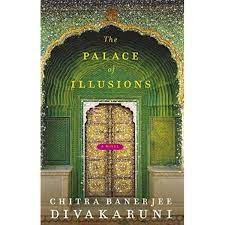 In The Palace of Illusions, Chitra Banerjee Divakaruni offers a refreshing reimagining of the Indian epic, the Mahabharata, through the eyes of Draupadi, or Panchaali, as she prefers to be called. As a reader, you’re offered a unique female perspective on a predominantly male-centric narrative, giving you a fresh take on an age-old tale.
In The Palace of Illusions, Chitra Banerjee Divakaruni offers a refreshing reimagining of the Indian epic, the Mahabharata, through the eyes of Draupadi, or Panchaali, as she prefers to be called. As a reader, you’re offered a unique female perspective on a predominantly male-centric narrative, giving you a fresh take on an age-old tale.
Divakaruni expertly weaves the story, plunging you into a world of royal intrigue, fervent passions, and colossal wars. At the heart of it all is Panchaali, who navigates through her life as a wife to five powerful yet flawed husbands, her role in a volatile kingdom, and her unrequited love for another.
You might find Divakaruni’s portrayal of Panchaali to be complex and multifaceted. She’s not just a princess or a queen; she is a woman with desires, ambitions, and insecurities. You get to witness her internal battles and her growth from a naive young girl into a queen who shapes her own destiny.
The narrative is filled with lush descriptions that paint a vivid picture of the mythic world, its grand palaces, the intricate social norms, and the epic battles. You might feel immersed in this world and invested in its characters.
The Palace of Illusions not only retells a classic tale but also challenges it, encouraging you to consider the untold narratives and hidden perspectives within the familiar. As you turn the last page, you might find yourself reflecting on the power of perspective, the complexities of duty and love, and the enduring strength of female characters in mythic tales. This novel leaves a lasting impression, making it a remarkable reading experience.
YONDER SUGGESTIONS
Yonder is a specialist India tour operator, including tailor-made, luxury holidays to India which can include any of the must see places discussed in this article.
Previous holidays which we’ve booked include India’s Golden Triangle and Tigers tour, a culture, wildlife and backwaters tour in Kerala and the hidden India Rajasthan tour. These can be great inspiration for your own itineraries.
We can also arrange luxury holidays which explore all the different aspects of India such as our Incredible India tour.
All Yonder itineraries are crafted on a tailor-made, one-off basis, so you can be sure that your holiday will be as individual as you are.
Yonder holidays aren’t the fly & flop type. Sure we all like a good hotel, but we travel to discover and learn, to connect with people, their places, and their culture. And what better way to connect with a culture than to read its stories.
A civilisation as ancient as India’s has a literary heritage that reaches back through the ages. But to help you relate and connect with modern India we’ve curated the following must-read contemporary novels for you to enjoy before your trip.
Pick up one or more of the following and get a headstart on the sights and sounds that await you in this complex, fascinating, and utterly bonkers nation.

Shortcut: our top picks reviewed in brief
The God of Small Things: a poignant exploration of familial relationships and societal taboos.
White Tiger: a riveting critique of India’s class struggle and a journey through the underbelly of Indian society.
Last Man in Tower: the collision of traditional values and rampant modernisation in a rapidly changing Mumbai.
Midnight’s Children: an immersive dive into India’s historical and political evolution through magical realism.
A Fine Balance: a deep exploration of human resilience and hope amidst political turmoil and socio-economic disparity.
The Inheritance of Loss: understanding the complexities of postcolonial identity and the immigrant experience.
The Palace of Illusions: a unique female perspective on an epic tale, challenging traditional narratives.
The God of Small Things
Arundhati Roy, 1997
 In her Man Booker Prize-winning debut novel, The God of Small Things, Arundhati Roy presents a captivating tale of twin siblings, Rahel and Estha, and their deeply troubled family in Kerala. Roy’s narrative is distinguished by its meticulous attention to detail, encapsulating the vast complexities of post-colonial Indian society within a microcosmic family drama.
In her Man Booker Prize-winning debut novel, The God of Small Things, Arundhati Roy presents a captivating tale of twin siblings, Rahel and Estha, and their deeply troubled family in Kerala. Roy’s narrative is distinguished by its meticulous attention to detail, encapsulating the vast complexities of post-colonial Indian society within a microcosmic family drama.
Set against a backdrop of immense socio-political change, the narrative is steeped in local culture, symbolisms, and the intricate caste system. The protagonists’ lives are profoundly influenced by the “Love Laws,” unspoken societal rules about who should be loved and how. These laws pose as a harsh reminder of the hierarchies that pervade even the most intimate aspects of life, marking individuals and determining their destinies.
Roy’s prose is rich and evocative, capturing the lush beauty of Kerala with vivid imagery while also addressing the heart-wrenching truths about human frailty and societal prejudice. The narrative does not follow a linear structure, but rather ebbs and flows through time, reflecting the lasting impacts of past tragedies on present circumstances.
The twins, Rahel and Estha, are portrayed with compelling depth and sincerity. Their innocence amidst the turmoil of the adult world and the irreversible consequences of a single tragic event result in a potent exploration of the fragility of childhood.
The God of Small Things is as much a poignant family saga as it is a commentary on the far-reaching implications of societal norms and prejudices. This masterpiece by Arundhati Roy will resonate with you long after the final page, invoking a reconsideration of the “small things” in life that invariably shape our destinies.
White Tiger
Aravind Adiga, 2008
 Aravind Adiga’s Man Booker Prize-winning novel, The White Tiger, is a dark yet witty narrative offering an unvarnished look into modern Indian society. The novel is presented as a confessional letter written by the protagonist, Balram Halwai, to the Chinese Premier, capturing the stark disparity between India’s rich and poor, urban and rural spaces, and their repercussions.
Aravind Adiga’s Man Booker Prize-winning novel, The White Tiger, is a dark yet witty narrative offering an unvarnished look into modern Indian society. The novel is presented as a confessional letter written by the protagonist, Balram Halwai, to the Chinese Premier, capturing the stark disparity between India’s rich and poor, urban and rural spaces, and their repercussions.
Balram, a self-proclaimed “social entrepreneur,” narrates his journey from a poor villager to a successful businessman in the sprawling metropolis of Bangalore. This transition is far from smooth, as it delves into themes of corruption, servitude, and moral compromise.
Adiga’s portrayal of Balram is immensely captivating – he is an anti-hero who elicits sympathy, despite his ruthless ambition and morally questionable actions. Balram’s voice is distinct and compelling; his wry observations and criticisms of the Indian elite are biting yet infused with a cynical humour that underscores the narrative.
The White Tiger excels in its depiction of the socio-economic chasm in Indian society. The author boldly addresses the systemic corruption and nepotism that are entrenched in both the political and social structures. The stark contrast between the ‘Light’ and ‘Darkness’ of India is reflected not only geographically but also symbolically, representing the dichotomy of India’s growth narrative.
Adiga’s prose is stark and incisive, laying bare the realities of India’s underbelly. While the novel may be uncomfortable to some due to its unflinching honesty, it is this very candour that makes The White Tiger a seminal work in contemporary Indian literature.
Last Man in Tower
Aravind Adiga, 2011
 Also by Aravind Adiga, Last Man in Tower is a thought-provoking novel that takes you to the heart of a rapidly changing Mumbai, where gleaming new skyscrapers stand in stark contrast to the city’s old, dilapidated buildings. At the centre of the narrative is the protagonist, retired schoolteacher Yogesh Murthy, affectionately known as Masterji.
Also by Aravind Adiga, Last Man in Tower is a thought-provoking novel that takes you to the heart of a rapidly changing Mumbai, where gleaming new skyscrapers stand in stark contrast to the city’s old, dilapidated buildings. At the centre of the narrative is the protagonist, retired schoolteacher Yogesh Murthy, affectionately known as Masterji.
Adiga draws you into the microcosm of the Vishram Society tower, a cooperative housing society in Mumbai. You observe Masterji’s stubborn refusal to sell his apartment to a powerful property developer, despite being the last remaining resident opposing the lucrative offer.
The narrative encapsulates the city’s transforming skyline as a symbol of India’s economic growth and the resulting societal shifts. Adiga paints a vivid picture of the city and the Vishram Society, making you feel the tension build as Masterji’s neighbours turn against him.
Adiga’s portrayal of Masterji and the other characters is detailed and empathetic. As you traverse the story, you may find yourself experiencing a range of emotions — from sympathy and admiration for Masterji’s principles, to frustration at his obstinacy, and sadness for the eventual outcome.
As you delve into Last Man in Tower, you explore deeper themes of greed, community, and the price of progress. Adiga’s Mumbai is a city of contradictions, and his characters mirror these complexities. By the end of the book, you may find yourself pondering over the complexities of urbanisation and the human cost of progress.
Last Man in Tower is a compelling read that offers a keen examination of modern India. It leaves you with a lingering thought: in the face of relentless modernisation, what happens to those who stand in its way? This narrative will resonate with you, as it encapsulates universal themes of change, resistance, and the indomitable human spirit.
Midnight’s Children
Salman Rushdie, 1981
 In Midnight’s Children, Salman Rushdie weaves a dazzling tapestry of postcolonial India, blending history and fantasy in an explosion of vibrant storytelling. This Booker Prize-winning novel recounts the story of Saleem Sinai, a boy born on the stroke of midnight, at the precise moment of India’s independence from British rule.
In Midnight’s Children, Salman Rushdie weaves a dazzling tapestry of postcolonial India, blending history and fantasy in an explosion of vibrant storytelling. This Booker Prize-winning novel recounts the story of Saleem Sinai, a boy born on the stroke of midnight, at the precise moment of India’s independence from British rule.
Saleem’s life is inextricably intertwined with the fate of his newly independent nation. He is bestowed with telepathic powers, as are the other 1,000 ‘midnight’s children,’ all born in the first hour of India’s independence. Their lives mirror the tumultuous events of India’s journey, from the partition and creation of Pakistan, to the imposition of ‘Emergency’ by Prime Minister Indira Gandhi.
Rushdie’s narrative is complex and intricate, told through Saleem’s perspective as he recalls his life’s journey to a young listener. The narrative structure, often flitting between different timelines, is imbued with Rushdie’s characteristic magical realism, adding a layer of fantastical wonder to the historical backdrop.
The novel is rich with symbolism and allegory, using Saleem’s telepathy as a metaphor for the interconnectedness of diverse experiences within India. The chaos of Saleem’s narrative mirrors the tumultuous nature of a country grappling with its newfound independence and the challenges it entails.
In his vivid portrayal of India, Rushdie addresses themes of identity, belonging, and postcolonialism, against the backdrop of a nation undergoing significant transition. His writing is lush with detail, bringing to life the sights, sounds, and smells of India and creating a sense of place that is deeply immersive.
Midnight’s Children is a tour de force of magical realism and a deep dive into the soul of postcolonial India. Rushdie’s distinctive storytelling style and imaginative narrative make this novel a landmark in the world of literature, offering an extraordinary journey through India’s history and the human condition.
A Fine Balance
Rohinton Mistry, 1995
 In A Fine Balance, Rohinton Mistry transports you to 1975 India, a time of political unrest and turmoil during ‘The Emergency’ declared by Prime Minister Indira Gandhi. The narrative intricately weaves the lives of four individuals, a widow, two tailors, and a student, each battling their own adversities amidst the sweeping changes.
In A Fine Balance, Rohinton Mistry transports you to 1975 India, a time of political unrest and turmoil during ‘The Emergency’ declared by Prime Minister Indira Gandhi. The narrative intricately weaves the lives of four individuals, a widow, two tailors, and a student, each battling their own adversities amidst the sweeping changes.
As the plot develops, you become privy to their hardships, hopes, and resilience, while experiencing the harsh realities of life under a regime of widespread fear and uncertainty.
Mistry’s prose is rich with detail, painting a stark and vivid picture of India during a pivotal period in its history. You can almost feel the oppressive heat, taste the spicy tang of street food, and hear the cacophony of bustling markets.
The novel’s title hints at the delicate equilibrium between hope and despair that underscores the narrative. As you explore the characters’ lives, you’ll see how this balance is frequently disrupted, forcing them to constantly adjust to their ever-changing circumstances.
A Fine Balance is not just a glimpse into India’s past; it’s an exploration of the human spirit’s tenacity in the face of overwhelming adversity. As you close the book, you might find yourself deeply moved and perhaps more appreciative of the delicate balance that makes up life’s tapestry. This book leaves you with a potent blend of melancholy and admiration for its characters, who despite their circumstances, continue to strive for a life of dignity and purpose.
The Inheritance of Loss
Kiran Desai, 2005
 The Inheritance of Loss, a Man Booker Prize-winning novel by Kiran Desai, is a narrative that delicately explores themes of postcolonialism, immigration, and identity. As you delve into this book, you become absorbed in the entwined lives of the characters residing in an old, crumbling house in the foothills of the Himalayas.
The Inheritance of Loss, a Man Booker Prize-winning novel by Kiran Desai, is a narrative that delicately explores themes of postcolonialism, immigration, and identity. As you delve into this book, you become absorbed in the entwined lives of the characters residing in an old, crumbling house in the foothills of the Himalayas.
Desai expertly manoeuvres the narrative across continents, as you follow the journey of Biju, an illegal immigrant in the United States, and the trials of his father and other characters back in India. Their stories reflect the dichotomy of the immigrant experience – the often romanticised dreams of the West versus the harsh reality.
Throughout the narrative, you are presented with the legacy of British colonialism in India and its impact on the characters’ identities. You witness the irony of the characters’ admiration for the West juxtaposed against their struggles to reconcile their cultural heritage.
Desai’s writing is dense and poetic, steeped in rich metaphors and vivid descriptions of the Indian landscape. As you navigate through her sentences, you might find yourself pausing to appreciate the beauty of her prose. Her skill in portraying the socio-political climate and the minute details of everyday life creates an immersive reading experience.
The Inheritance of Loss is a novel that compels you to contemplate the complexities of a postcolonial world, where identities are in constant flux and the notion of ‘home’ is elusive. As you reach the end, you’re likely to be left with an indelible impression of the characters’ resilience in the face of loss and their unending quest for belonging. This is a book that resonates with our shared human experience of striving, failing, and the perpetual journey of finding oneself amidst the chaos.
The Palace of Illusions
Chitra Banerjee Divakaruni, 2008
 In The Palace of Illusions, Chitra Banerjee Divakaruni offers a refreshing reimagining of the Indian epic, the Mahabharata, through the eyes of Draupadi, or Panchaali, as she prefers to be called. As a reader, you’re offered a unique female perspective on a predominantly male-centric narrative, giving you a fresh take on an age-old tale.
In The Palace of Illusions, Chitra Banerjee Divakaruni offers a refreshing reimagining of the Indian epic, the Mahabharata, through the eyes of Draupadi, or Panchaali, as she prefers to be called. As a reader, you’re offered a unique female perspective on a predominantly male-centric narrative, giving you a fresh take on an age-old tale.
Divakaruni expertly weaves the story, plunging you into a world of royal intrigue, fervent passions, and colossal wars. At the heart of it all is Panchaali, who navigates through her life as a wife to five powerful yet flawed husbands, her role in a volatile kingdom, and her unrequited love for another.
You might find Divakaruni’s portrayal of Panchaali to be complex and multifaceted. She’s not just a princess or a queen; she is a woman with desires, ambitions, and insecurities. You get to witness her internal battles and her growth from a naive young girl into a queen who shapes her own destiny.
The narrative is filled with lush descriptions that paint a vivid picture of the mythic world, its grand palaces, the intricate social norms, and the epic battles. You might feel immersed in this world and invested in its characters.
The Palace of Illusions not only retells a classic tale but also challenges it, encouraging you to consider the untold narratives and hidden perspectives within the familiar. As you turn the last page, you might find yourself reflecting on the power of perspective, the complexities of duty and love, and the enduring strength of female characters in mythic tales. This novel leaves a lasting impression, making it a remarkable reading experience.
YONDER SUGGESTIONS
Yonder is a specialist India tour operator, including tailor-made, luxury holidays to India which can include any of the must see places discussed in this article.
Previous holidays which we’ve booked include India’s Golden Triangle and Tigers tour, a culture, wildlife and backwaters tour in Kerala and the hidden India Rajasthan tour. These can be great inspiration for your own itineraries.
We can also arrange luxury holidays which explore all the different aspects of India such as our Incredible India tour.
All Yonder itineraries are crafted on a tailor-made, one-off basis, so you can be sure that your holiday will be as individual as you are.

 GBP
GBP
